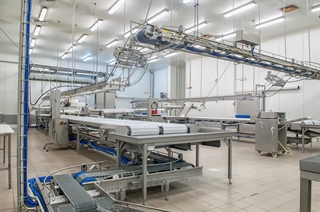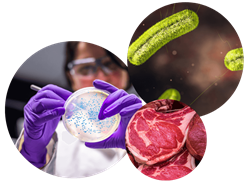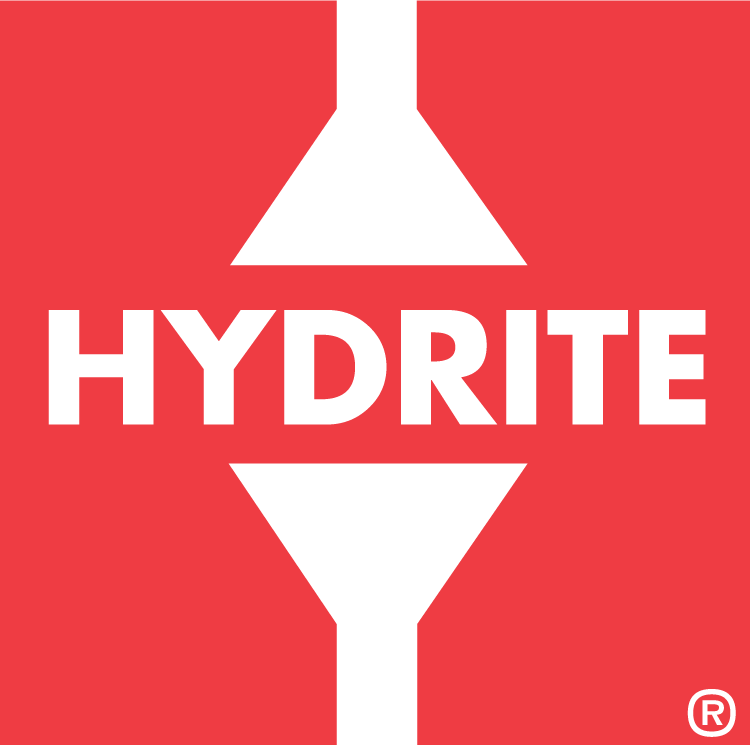Clean sanitize disinfect
Sanitation Vs Disinfection
Proper plant sanitation and disinfection is crucial in food processing operations. It is important for surfaces used in food processing to remain clean in order to ensure the safety of those consuming the food products in the future. Chemical disinfection and sanitation are both of great importance in keeping surfaces clean, but each of these compounds serve a unique purpose in the process.
Sanitizing Vs Disinfecting in Food Processing
Sanitation is the process of reducing bacterial contamination to levels judged to be safe as determined by public health authorities. The term “sanitizer” is regulated by the EPA and requires strict laboratory tests in order to verify. The compound must pass the Sanitizer Efficacy Test in order to bear the sanitizer label. By definition, sanitizers do not disinfect or sterilize.
Sanitizer used in food contact must kill 99.999% or a 5-log reduction of 75 million to 125 million nonpathogenic Escherichia coli (Gram-negative) and Staphylococcus aureus (Gram-positive) bacteria in 30 seconds at 68 degrees Fahrenheit. If there are 1,000,000 bacteria, then only 10 can remain after 30 seconds.

Disinfectants, on the other hand, are chemical substances that kill a wider range of microorganisms, which could include: Bacteria, Fungi, Viruses
In general, disinfectant levels are not used on food contact surfaces or people. If used on food contact surfaces, a rinse must be conducted post-disinfectant process.
A chemical used as a sanitizer can often be used as a disinfectant if used in higher concentrations and a longer contact time. Check the label of your sanitizer for instructions on how to use the compound as a disinfectant.
What Type of Applications Require Cleaners, Sanitizers, or Disinfectants?
It is essential to use the appropriate cleaning, sanitizing, and disinfecting products in each of these food processing applications to ensure food safety and regulatory compliance. The choice of products may depend on the specific needs and requirements of the facility, as well as the types of contaminants that need to be controlled. Cleaners, sanitizers, and disinfectants are essential in various food processing applications to maintain food safety, prevent contamination, and ensure the quality of food products. Some of the key food processing applications that require these products include:
Equipment and Utensil Cleaning: Cleaning and sanitizing food processing equipment, utensils, filling machines, beverage dispensing and sanitary filling equipment, bottle washing units, tanks, meat and poultry, fruit, and vegetable conveyors, and hard, non-porous food contact surfaces are crucial to prevent cross-contamination and the spread of pathogens.
Food Contact Surfaces: Surfaces that come into direct contact with food, such as conveyor belts, slicers, and food packaging materials, need to be regularly cleaned and sanitized to prevent the transfer of bacteria, viruses, and other contaminants.
Food Preparation Areas: The areas where food is prepared, including countertops, workstations, and kitchen tools, must be cleaned and sanitized to maintain a hygienic environment.
Food Storage and Handling: Refrigeration units, storage containers, and shelving used for storing raw and processed food products need to be regularly cleaned and sanitized to prevent spoilage and contamination.
Processing Equipment: The machinery and equipment used in food processing, such as blenders, mixers, and grinders, require cleaning and sanitization to ensure the safety and quality of the processed food.
CIP (Clean-In-Place) Systems: Many food processing facilities use automated CIP systems to clean and sanitize processing equipment and pipelines without disassembling them, improving efficiency and hygiene.
Production Floors: The entire production area, including floors, walls, and ceilings, must be cleaned and disinfected regularly to maintain a sterile environment and prevent contamination.
Water Treatment: Water used in food processing should be treated and sanitized to ensure that it is free from harmful microorganisms and chemicals. Treatment of process water, cooling water, and wastewater.
Employee Hygiene: Proper handwashing stations, sanitizers, and personal protective equipment should be available to maintain the hygiene of food processing workers.
Transport and Distribution: Vehicles and containers used for transporting food products should be cleaned and sanitized to prevent contamination during transit.
Waste Disposal: Waste disposal areas should also be maintained in a clean and sanitized condition to prevent the attraction of pests and the spread of contaminants.
What Types of Cleaners, Sanitizers, and Disinfectants are Available for Food Processing?
![]()
At Hydrite, we offer a full range of products for cleaning, sanitization, and disinfection applications used in a variety of industries. Below is a list of products including many that are on the EPA’s Registered Antimicrobial Products. We have a team of experts dedicated to helping our customers select the right products and services, and offer guidance and training on proper cleaning procedures.
Contact Us for product and application assistance or Request a Quote.
Click on the product name for additional information.
PRODUCT NAME |
FEATURES AND BENEFITS |
APPLICATIONS |
| HYDROXYSAN + NO. 494 | •Exhibits excellent bactericidal activity and fungal* control against a wide range of microorganisms in cold or warm water. •EPA registered PAA sanitizer *Refers to non-public health organisms |
•Used for CIP pipeline, filling machines, bottle washing, and tank cleaning, sanitization, and disinfection •Used in the treatment of process water, cooling water, and wastewater •Used to control slime and biofouling in RO and UF membranes |
| HYDROXYSAN 1522 | •EPA registered PAA Sanitizer •FDA regulated •Is an effective no-rinse final sanitizer on pre-cleaned food contact surfaces |
•Used as a sanitizer in bottling and beverage dispensing equipment •Controls the growth of odor-causing and slime-forming bacteria •Used as a dip or spray wash, or fog to control the growth of non-public health microorganisms |
|
•EPA registered sodium hypochlorite sanitizer |
Used for sanitizing food contact surfaces |
|
|
•No rinse sanitizer when used according to label directions |
Used as a concentrated liquid quaternary sanitizer |
|
|
•EPA registered quat sanitizer, disinfectant |
Used as a concentrated liquid quaternary sanitizer for use in sanitizing equipment and as a disinfectant |
|
|
Well-known cleaning agent; most commonly used for bleaching and cleaning. |
For use in surface, commercial and household laundry sanitizers, drinking water and wastewater treatment disinfectants |
|
|
Sterilex Ultra Disinfectant Cleaner Solution 1 when used with Sterilex Ultra Activator Solution |
•Compatible with wastewater systems |
•Used for biofilm removal (industrial applications), hard surface disinfection and sanitization •Food contact surfaces, environmental surfaces, and drains, COP tank (soaking), floors, and poultry and swine waterline sanitization |
|
Sterilex Ultra CIP (NOFOAM) |
•EPA registered •Compatible with wastewater systems •Broad spectrum killing ability •Effective against mold, mildew, and spoilage organisms •Used for both remediation of microbial challenges as well as rotational maintenance usage •EPA claim for human coronavirus & emerging viral pathogens |
Used as a disinfectant approved to kill organisms such as Listeria, Salmonella, and E. coli, in CIP systems and brine injection/needle sanitation systems |
|
Sterilex Ultra Step |
•EPA registered sodium carbonate peroxyhdrate floor sanitizer •Reduce risk of organism spread •Kills common food pathogens •Controls organism transfer from foot traffic and equipment movement •Will not freeze in low temperature environments •EPA claim for human coronavirus & emerging viral pathogens |
Sanitizer for floor surfaces, boots, floor mats, and foot pans in USDA, FDA, and CFIA inspected food facilities and animal environments. Doorway intervention; Animal premise sanitization; Poultry and swine premise sanitization |
|
Pure Hard Surface Disinfectant |
•Fast and effective with superior efficacy •Approved for use on food contact surfaces without the requirement of a rinse. •24-Hour Protection when used as directed - continues to kill common bacteria for up to 24-hours. •Lowest EPA Toxicity Rating - meets the EPA requirements for a Category IV rating with no Precautionary or First Aid statements required. •Silver Ion Citric Acid •EPA claim for human coronavirus |
•A colorless, odorless, ready-to-use disinfectant and sanitizer for use on hard non-porous, environmental surfaces, including food contact surfaces •Rapidly eliminates bacteria, viruses and fungi, including multiple drug resistant organisms (CRE, MRSA, VRE), Human Coronavirus, Norovirus, Hepatitis B and C, Listeria, E. coli and Salmonella with kill times as fast as 30 seconds |
|
Alpet D2 Surface Sanitizer |
•Kills 99.999% of 9 tested pathogens in 60 seconds on food contact surfaces, including non-porous rubber gloves |
Isopropyl alcohol based hard surface sanitizer used for cleaning, disinfection, and sanitizing non-food and food contact surfaces, footwear, and gloves |
|
Alpet D2 Surface Sanitizer – Quat Free |
•10 second kill on non-food contact surfaces, including non-porous rubber footwear •Ready-to-use • No-rinse required • No unsightly residue •NSF listed D2 classification • EPA registered •CDC guidance for coronavirus •70% or greater alcohol |
Isopropyl alcohol based hard surface sanitizer used for cleaning, disinfection, and sanitizing food and non-Food contact surfaces, footwear, and gloves |
|
Alpet Q E2 Sanitizing Foam Soap |
•Meets all USDA requirements for food handling •NSF Listed E2 classification - Kosher, Pareve and Halal certified •Recommended for repeated use •CDC guidance for hand washing |
•Used as a handwash to help reduce bacteria that potentially can cause disease •Helps to prevent cross-contamination by hand contact |
|
Bac Stop 2 |
•Provides proven anti-bacterial protection for hands •Meets or exceeds UDSA guidelines for E2 rated hand soaps •CDC guidance for hand washing |
May be used as a hand soap or dish detergent. Will not chafe or irritate skin |
|
Alpet E3 Plus Hand Sanitizer |
•Helps to prevent cross-contamination |
Used to sanitize hands and help reduce bacteria that potentially can cause disease |
|
Bac Stop 3A |
•Premium pH balanced formula that is mild on skin |
Intended for use as a no-rinse hand sanitizer for using in food plant environments |
It is a violation of federal law to use these products in a manner inconsistent with its labeling.
Product safety information and handling precautions are contained on the product label and Safety Data Sheet (SDS). READ AND UNDERSTAND LABEL AND SAFETY DATA SHEET BEFORE PRODUCT USE.
Consult the label for specific applications and use requirements; and contact your Hydrite representative for specific recommendations.*
See our Products page for more products.

Contact Us
Get in touch to discuss your food processing sanitation needs.
